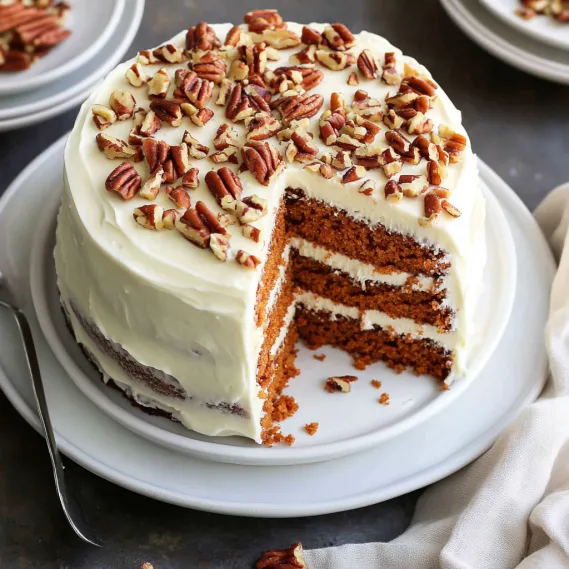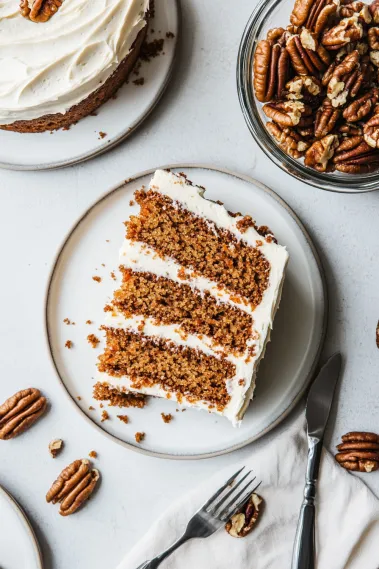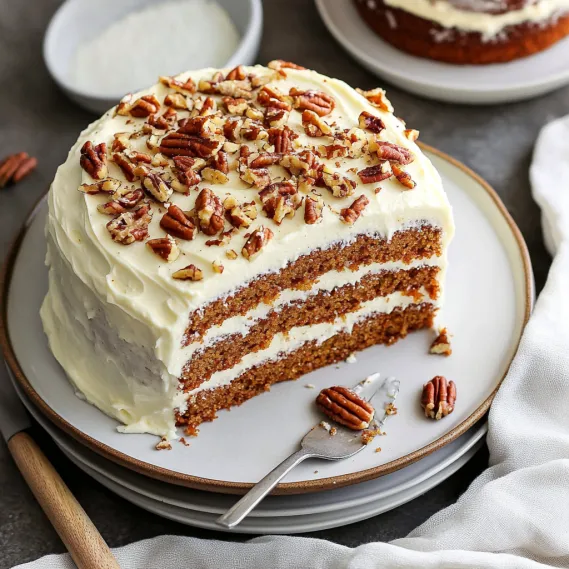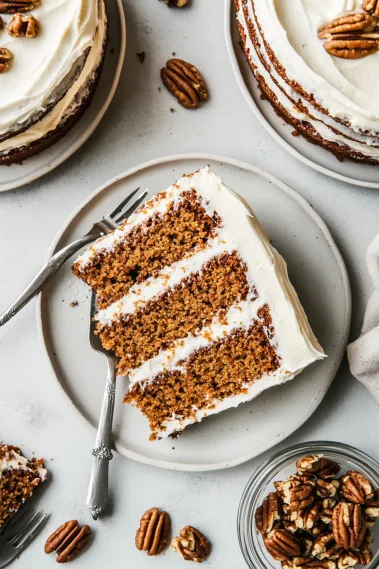 Pin it
Pin it
This exceptional carrot cake delivers everything you could possibly want in this classic dessert—deeply moist layers bursting with warm spices, freshly grated carrots, and toasted pecans, all wrapped in velvety cream cheese frosting. The combination of brown sugar and oil creates an incredibly tender crumb that actually improves with time, making this the perfect make-ahead dessert for special occasions. Whether for birthdays, Easter celebrations, or any gathering that calls for something truly special, this carrot cake consistently converts even the most skeptical "I don't like carrot cake" people into devoted fans after just one bite.
I make this cake every year for my own birthday, a tradition I started after realizing no other dessert brings me quite the same joy. What began as a personal favorite has become my signature dessert among friends and family—to the point where I no longer ask what dessert people want for gatherings. They always request "THE carrot cake," and honestly, I'm more than happy to oblige because it never disappoints!
Essential Ingredients and Selection Tips
- Brown Sugar: Use dark brown sugar for the deepest flavor and moisture. This is key to the cake's exceptional texture and isn't just for sweetness.
- Oil: A neutral vegetable or canola oil keeps the cake incredibly moist without adding competing flavors. Avoid substituting butter here.
- Freshly Grated Carrots: The secret weapon of truly great carrot cake. Pre-shredded carrots are too dry; grating them yourself ensures they release maximum moisture into the batter.
- Toasted Pecans: Taking the extra few minutes to toast them enhances their flavor dramatically. They add wonderful texture and nutty depth.
- Cream Cheese: Use full-fat brick-style cream cheese for the frosting. The spreadable kind in tubs contains additives that prevent it from achieving the proper consistency.
I've discovered through years of making this cake that the freshly grated carrots are absolutely non-negotiable. The first time I tried using pre-shredded carrots from the store, the difference was immediately noticeable - the cake was significantly drier and lacked that special moisture that makes carrot cake so irresistible.
Detailed Cooking Instructions
- Step 1: Prepare Your Foundation
- Preheat your oven to 300°F (149°C) and spread pecans on a baking sheet. Toast for 7-8 minutes until fragrant, then cool and chop. Increase oven temperature to 350°F (177°C) and grease two 9-inch cake pans, lining the bottoms with parchment paper rounds for easy release.
- Step 2: Mix The Batter Properly
- Whisk flour, baking powder, baking soda, salt, cinnamon, ginger, and nutmeg in one bowl. In a separate large bowl, whisk brown sugar, granulated sugar, oil, applesauce, eggs, and vanilla until completely smooth. Pour the dry ingredients into the wet ingredients and gently fold together until just combined.
- Step 3: Add The Star Ingredients
- Fold freshly grated carrots and toasted pecans into the batter until evenly distributed, being careful not to overmix. The batter will be slightly thick but pourable. Divide it evenly between prepared pans and smooth the tops with a spatula for even baking.
- Step 4: Bake To Perfect Moisture
- Bake at 350°F (177°C) for 30-35 minutes until a toothpick inserted in the center comes out with a few moist crumbs. Allow cakes to cool completely in pans on wire racks before removing, as they're very moist and need time to set.
- Step 5: Create Irresistible Frosting
- Beat cream cheese and butter together until completely smooth, then add powdered sugar, vanilla, and a pinch of salt. Mix until creamy and spreadable. Once cakes are completely cool, frost generously between layers, on top, and around the sides, creating beautiful swirls for a professional finish.
 Pin it
Pin it
I learned the importance of proper cake storage through trial and error. The first time I made this for a party, I frosted it and left it at room temperature for several hours on a warm day. The cream cheese frosting began to soften and slide. Now I know to refrigerate it until about an hour before serving, which keeps everything perfectly intact while still allowing the cake to be enjoyed at the ideal temperature.
The Secret To Perfect Wok Technique
High heat is essential for authentic fried rice. My grandmother taught me to heat the wok until smoking before adding oil. Keep ingredients moving constantly to achieve that elusive "wok hei" flavor. Never overcrowd the pan—cook in batches instead. This technique transformed my fried rice into restaurant-quality perfection.
 Pin it
Pin it
Making The Most Of Leftovers
This dish excels at transforming leftovers into something exciting. I've used roast chicken, holiday ham, and even Thanksgiving turkey with great success. Cut meat into uniform pieces that distribute evenly throughout. Leftover grilled steak adds incredible depth with its smoky edges. Even roasted vegetables bring delightful caramelized sweetness.
Balancing Flavors And Textures
Special fried rice succeeds through balanced components. Char siu provides richness, prawns add sweetness, eggs contribute silkiness, while vegetables offer freshness. The sequence matters—aromatics first build flavor, eggs midway remain distinct, vegetables maintain crispness. Adding spring onions last preserves their brightness for that authentic restaurant finish.
Customization For Dietary Needs
This dish adapts easily to dietary restrictions. For vegetarians, I omit meat, double eggs and add extra vegetables. Low-carb diners enjoy my cauliflower rice version that carries flavors beautifully. For gluten-sensitive guests, tamari replaces soy sauce while ensuring chicken powder is certified gluten-free. Everyone enjoys this beloved dish regardless of restrictions.
Carrot Grating Wisdom
The technique you use for grating carrots can significantly impact your cake's texture. I've tried every method—box grater, food processor, even the grating attachment on my stand mixer—and have found that the standard box grater using the medium-sized holes produces the ideal carrot consistency. Food processors tend to create pieces that are either too fine (turning almost to mush) or too chunky. When grating by hand, you'll notice the carrots release moisture that collects on your work surface—this is liquid gold for your cake! I always scrape this juice into the batter as well, as it contains both flavor and moisture. Four large carrots typically yield about 2 cups of grated carrots, which is perfect for this recipe.
Make-Ahead Magic For Special Occasions
This carrot cake is my go-to for entertaining because it actually improves with time. For special occasions, I've developed a stress-free timeline: Up to 2 days before: Bake the cake layers, cool completely, wrap tightly in plastic wrap and refrigerate. 1 day before: Prepare the frosting, assemble and frost the cake, then refrigerate overnight. The day of serving: Remove from refrigerator 1-2 hours before serving to allow it to come to room temperature for the best flavor and texture. This approach not only divides the work but actually enhances the cake as the spices intensify and the frosting slightly penetrates the top of each layer, creating an even more tender eating experience. I've received countless compliments specifically noting how moist and flavorful the cake is, which I attribute largely to this make-ahead method.
Decorating Options For Every Occasion
While a simply frosted carrot cake is always beautiful, I enjoy tailoring the decoration to different celebrations. For spring gatherings, I sometimes create a nest of thin carrot curls (made with a vegetable peeler) on top and add a few marzipan "eggs" for an Easter theme. For more elegant occasions, I pipe rosettes around the top edge and place a single edible flower in the center. When making this for children's birthdays, I've been known to tint a portion of the frosting orange and pipe little carrots on top, which always delights young guests. The cream cheese frosting holds piped designs beautifully if chilled first, allowing for creative expression while maintaining that classic carrot cake flavor everyone loves.
 Pin it
Pin it
This carrot cake recipe has become my signature dessert over the years, the one friends and family request for special occasions and the one I turn to when I want to make something I know will be universally loved. There's something deeply satisfying about serving a slice of this spiced, moist cake with its crown of tangy frosting and watching someone close their eyes with pleasure at the first bite. It's more than just dessert—it's a way to create moments of pure joy around the table, which is really what baking is all about.
Frequently Asked Questions
- → Why is my carrot cake dense instead of fluffy?
- Several factors can cause a dense carrot cake: 1) Overmixing the batter after adding the flour develops too much gluten, 2) Using too many wet ingredients without balancing dry ingredients, 3) Not using enough leavening agents, or 4) Opening the oven door too early during baking. Make sure to fold the wet and dry ingredients just until combined, measure accurately, and resist peeking while baking. Also, freshly grated carrots provide better moisture than pre-shredded ones.
- → Can I make this cake dairy-free?
- You can adapt the cake portion to be dairy-free by using melted coconut oil or another vegetable oil. For a dairy-free frosting, you'll need to use dairy-free cream cheese and butter alternatives specifically designed for baking. Note that the texture and flavor will be slightly different, but still delicious. Make sure all your other ingredients (like the sugar) don't contain hidden dairy ingredients if this is for someone with a dairy allergy.
- → How do I prevent my cream cheese frosting from being runny?
- To achieve a firm cream cheese frosting: 1) Use full-fat brick-style cream cheese, not the spreadable kind in tubs, 2) Make sure both the cream cheese and butter are cool but softened, not warm or melty, 3) Beat the cream cheese and butter together until just smooth - overbeating adds air and heat which can make it runny, 4) Add confectioners' sugar gradually, and 5) If it's still too soft, refrigerate for 20-30 minutes before using. In warm kitchens, you may need to refrigerate the frosting briefly before spreading.
- → Can I add other ingredients like pineapple, raisins, or coconut?
- Yes! This recipe is adaptable for add-ins. If adding pineapple, use well-drained crushed pineapple (about 1/2 cup) and reduce the applesauce to 1/4 cup to balance moisture. For raisins or shredded coconut, add up to 1 cup total of any combination of these ingredients. If adding extra items, reduce the pecans to 1/2 cup (or omit them) to maintain the proper ratio of wet to dry ingredients. Stick to around 1-1.5 cups total add-ins for best results.
- → How far in advance can I make this cake?
- This carrot cake is perfect for making ahead: 1) Unfrosted cake layers can be wrapped tightly and kept at room temperature overnight or frozen for up to 3 months, 2) The frosting can be made 1-2 days ahead and refrigerated (bring to room temperature and re-mix before using), 3) The fully frosted cake can be refrigerated for up to 5 days, or 4) Frozen for 2-3 months (thaw overnight in the refrigerator). Allow refrigerated cake to sit at room temperature for 30 minutes before serving for the best flavor and texture.
- → Why do I need to toast the pecans?
- Toasting the pecans is worth the extra few minutes because it: 1) Intensifies their nutty flavor by releasing natural oils, 2) Improves their texture, making them crunchier, 3) Helps them maintain their texture when mixed into the moist batter, and 4) Enhances the overall depth of flavor in the cake. If you're in a hurry, you can skip this step, but the difference in flavor is noticeable. You can also toast them ahead of time and store in an airtight container until needed.
